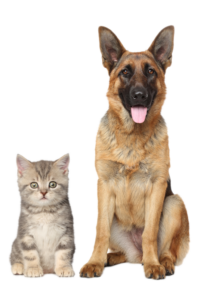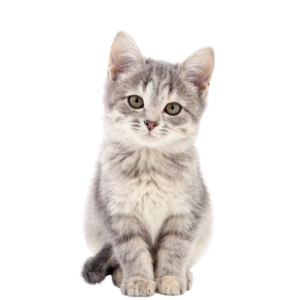Maintaining healthy teeth, mouth and gums is key to securing your pet’s comfort and health at all times. Our team offers a wide variety of services that will help keep your furry friend’s pearly whites shining throughout their entire life. A healthy mouth is a very important part of your pet’s overall well being. The following are common questions regarding oral health. We have provided some interesting links at the end of the page for further information.
Why should I brush my dog’s or cat’s teeth?
Daily removal of plaque is key for your pet’s oral hygiene. Unless your pet’s teeth are brushed daily, plaque, which is the accumulation of bacteria, will build up at the gum line. Eventually calculus (tartar) forms, further irritating the gums, and then infection begins to loosen and destroy the attachment of the tooth. In addition to loose teeth, infection under the gum line can spread to the liver, kidneys and heart.
How can I brush my pet’s teeth?
It can be challenging at first, but with a bit of practice and patience, brushing can easily be accomplished.
- Step 1: Pick a soft-bristled or finger toothbrush and use a toothpaste from your veterinarian. (If your pet has a certain food allergy like chicken, make sure you don’t use that flavour). Do not use human toothpaste because it has detergents and fluoride that should not be swallowed.
- Step 2: Get your pet to lick the flavoured toothpaste off your finger. Then slowly work up to rubbing the teeth with the toothpaste and your finger or a finger brush. Eventually your pet will tolerate a toothbrush. Remember to give your pet lots of tasty treats as a reward for being compliant. This will make the process easier and eventually make it an enjoyable experience for both of you.
How often should my pet have a dental prophylaxis at the veterinary hospital?
It depends on the degree of plaque and calculus accumulation. Your pet’s teeth should be examined monthly. Look for accumulation of yellow or brown material at the area where the tooth meets the gum line especially over the cheek teeth and canines. Remember, attached to the calculus are bacteria, which irritate the gum tissues and cause inflammation (gingivitis). When treated, the inflammation will resolve. When gingivitis is left untreated, it will progress to periodontitis, which is non-curable.
It is best to have the dental prophylaxis done as soon as you can, to avoid additional damage. Once you notice plaque or calculus, make an appointment with your veterinarian so that your pet can be set up for a professional cleaning. The intervals between teeth cleaning procedures will depend on a few things, like how often you can brush your pet’s teeth, your pet’s age and breed. On your pet’s annual exam, your veterinarian will be able to tell you if a dental prophylaxis is needed.
Can I use my fingernail or a dental scaler to remove tartar from my pet’s teeth?
Dental disease occurs below the gum line. By removing tartar or calculus from the tooth, you are not removing the disease below the gum line. In order to thoroughly help your cat or dog, plaque and calculus must be removed from below the gum-line.
Is it necessary to use anaesthesia to clean my pet’s teeth?
Anaesthesia is necessary when performing teeth cleaning. Anaesthesia provides three important functions:
- Immobilization to clean below the gum line
- Pain control for your pet
- Ability to place a tube down the windpipe, so bacterial products do not enter the respiratory system and cause additional harm
Is anaesthesia safe for dogs/cats?
Our team takes every effort to provide safe anaesthesia. Dogs and cats are given pre-anaesthetic blood panel to test organ function. All of our patients also undergo an examination with one of our veterinarians to qualify them for anaesthesia. Patients are monitored by our qualified technicians while under anaesthetic visibly and with monitoring devices similar to those used in human hospitals.
What happens during a dog/cat/pet teeth cleaning?
Each oral assessment, treatment, and prevention visit has 14 different steps:
- Pre-anaesthetic blood panel to check organ function
- Pre-anaesthetic exam before anaesthesia
- An oral exam under anaesthetic
- Full mouth dental radiographs
- Dental charting to create a treatment plan
- Scaling of the tooth’s surface
- Subgingival (below the gum line), root planing and curettage
- Teeth polishing
- Oral irrigation
- Application of an oral antiseptic
- Post cleaning oral exam
- Additional therapy like extractions or surgery if required
- Home care instructions and medications
- Complimentary follow up appointment if extractions have been done
How much does dog/cat/pet teeth cleaning cost?
It is not possible to determine what the procedure will cost because we do not know the status of your pet’s teeth and gums. Fees for the dental cleaning are standard, however, the extractions/surgery costs are based on the length of the procedure and medications depend on the specific case. If your pet has not had a recent exam, your veterinarian will need to examine your pet to make sure that your pet is healthy enough to undergo an anaesthetic procedure and will make an estimate for you based on the treatments that need to be done. Please contact us to schedule your next dental appointment.
Is there food that can help with dental disease in dogs/cats/pets?
Yes, there are special diets formulated to help control plaque and tartar. Some of the brands we recommend are Medi-Cal/Royal Canin Dental Diet and Hills T/D which combine specific kibble size and tartar reducing ingredients to provide double action dental care against the formation of dental plaque and tartar. When used with brushing, the amount of dental prophylaxis’ needed can be reduced with these specialized pet foods.
What toys should I avoid to protect my pet’s teeth?
You should prevent your pet from chewing on objects harder than their teeth, as this can lead to dental fractures. Be especially careful with cow and horse hooves, as well as rocks. Tennis balls can also be abrasive. For example, tug-of-war can sometimes cause growing teeth to move to abnormal locations and throwing dog disks could increase the chance of trauma to the teeth.
What are Feline Orthodontic Resorptive Lesions?
Many cats get painful lesions at the gum line that invade their teeth. Unfortunately, we do not know what causes this and generally the affected tooth will need to be extracted. The doctor can often tell if your cat has an advanced resorptive lesion during an exam by pressing on the gum line. If the painful lesion is noted, your cat will chatter its jaw. We also often find them while the cat is under anaesthetic and the teeth have been cleaned.
How can I tell if my pet is suffering from periodontal disease?
One of the common signs is halitosis or bad breath. Dogs and cats should not have disagreeable mouth odour. Bad breath comes from infection. If you notice this, contact our team immediately so that your veterinarian can examine your pet’s mouth and advise care. Other signs may be difficulty chewing and excessive drooling.
What type of tests are done to diagnose dental disease?
After your veterinarian has performed an exam and decided that a dental prophylaxis is warranted, an oral exam is performed once the pet is under anaesthetic. This way we can safely probe around the tooth to evaluate bone loss around each tooth. X-rays will be taken to evaluate if the teeth can be saved, or if it needs to be extracted.
When should I start doing dental care on my pet?
It is recommended to start brushing your cat’s or dog’s teeth right away. Whether you start when they are puppies or kittens, or when they are seniors, it will take time to get your pet used to brushing. Now is a good time to start! Ask the team at our veterinary hospital about brushing.
We have lots of informational sheets and can walk you through how to start and get your pet comfortable with the procedure so it can continue for life.
What can be done if my pet has periodontal disease?
Periodontal disease occurs when tooth support structures are affected by infection. The disease is under the gum line, so in the beginning stages, cleaning below the gum line and removing plaque and tartar from above the gum-line will help restore periodontal health. In advanced cases, either periodontal surgery or extractions are performed.
Which animals are more at risk for periodontal disease?
Periodontal disease affects approximately 95% of dogs and 70% of cats over 5 years of age. Some individual cats and dogs are genetically predisposed to develop dental disease at a younger age or experience more severe periodontal disease. Smaller breeds, for example, are more prone than larger breeds because their teeth are closer together.
My pet’s teeth look bad, but he/she is still eating fine. Is he/she in pain?
You may have noticed by now that pets can be quite stoic. This is instinctual, as to show pain is to show weakness in the animal kingdom. By the time your pet stops eating, the pain he or she is experiencing is likely very severe.
For more information, please check out the links below or call us at 250-926-0006.
How to Brush Your Pet’s Teeth (Videos):



